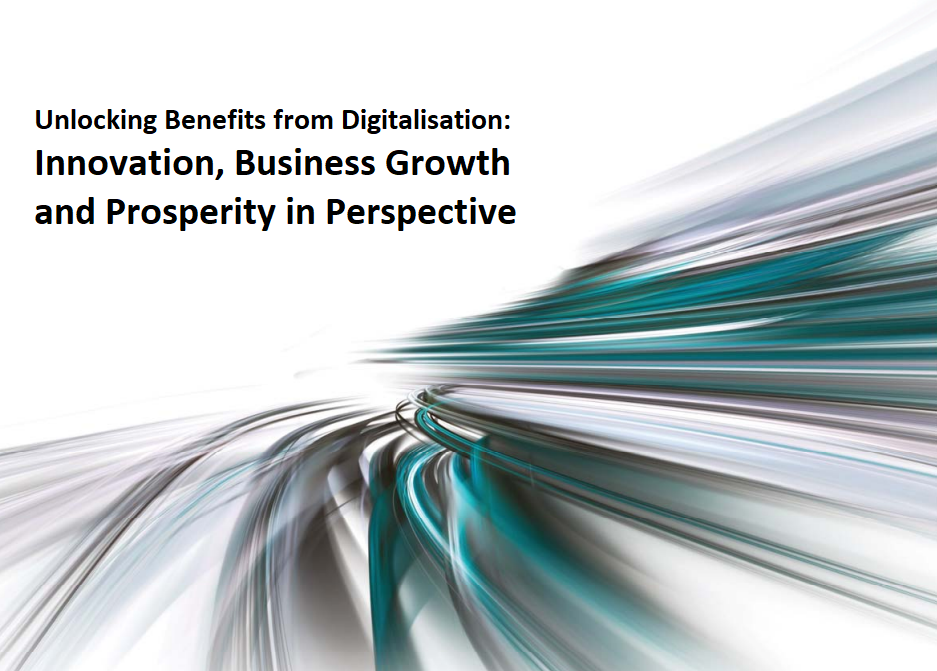Unlocking Benefits from Digitalisation: Innovation, Business Growth and Prosperity in Perspective
The digital revolution makes a massive amount of information available at much greater speed than was previously thought possible, spanning technical specifications, market analysis, competitors, social dynamics, external events, etc. The implications are profound for corporations of all kinds, as well as for public institutions, academia, and civil society.
When applied to spur solutions that are “new”, digitalisation feeds innovation which, in turn, may take multiple shapes, ranging from technical and commercial to social and inclusive. Extensive research identifies digitally bred innovation as of major importance for productivity, profitability, business growth, as well as for disseminating new ideas and enacting social change.
Benefits of digitalisation materialise through multiple mechanisms. The diffusion of mobile telephony and convergence with the Internet have wired and connected people all over the world, a development that keeps unfolding at a remarkable pace. With access to information and means for electronic commerce, transparency have increased and created a more level playing field in the marketplace. E-health, e-learning, social networks, and so forth, propel a wide spectrum of social as well as economic gains.
Meanwhile, digitalisation opens for powerful network effects propelling huge economies of scale and scope. Platform economy dynamics connects providers with users, by-passing middlemen, lowering transaction costs and opening for better matched service provision. Today, for businesses around the world, improved data analytics, cloud computing, internet of things, and artificial intelligence are referred to as of high priority (Deloitte, 2020).
Yet, the benefits of digitalisation are far from given, and there are costs too. Far from all realms of business excel in innovation, or thrive on the back of investment in Information and Communications Technology (ICT). Despite the documented importance of digitalisation for innovation and value-creation, many organisations struggle to realise lasting gains. What has become known as the “digital divide” convey that digitalisation, rather than diminishing gaps in terms of income and opportunity, may serve to conserve or even increase them as well.
From early on, the literature highlighted the key role played by software rather than hardware, and the use rather than the production of ICT, for generating benefits (OECD, 2001). Rather than a supply-push of technology and applications for artificial purposes, gains hinges on demand pulling development efforts towards meeting with outstanding needs. A business proposition must match market openings and achieve a vibrant customer base.
Realising the potential benefits is not just about ICT. Training, research, along with restructuring and organisational change, are of high importance. In the process, a firm needs to overcome competitors, fill in the “gaps” when it comes to weaknesses, while better defining its edge. ICT must not replace, but instead ensure making use of knowledge that resides in clients, customers, and citizens.
Another key dimension centres on how to manage resources and cope with risk (Bettiga and Ciccullo, 2019). While access to capital is a major factor throughout, different kinds of firms meet with very different issues. For entrepreneurs or firms at early stages, capital requirements are generally modest but risks are high. With patient seed funding in thin supply, family, friends, and fools typically represent the only options at hand to bring in cash.
At the opposite end, once risks subside for a firm that has grown and its concept has gained acceptance, bank lending and IPOs becomes available to propel scaling. In between, the difficulties of bridging is popularly known as the “Valley of Death” for aspiring new ideas.
In order for start-ups to emerge and grow, diverse sources of funding thus need to be mobilised along the way, e.g., public seed funding, angel investment, and private equity. The common lack of such avenues indicates systemic failure to foster an innovation system capable of cherishing new ideas and managing risk. Under such circumstances, the seeds of today cannot develop the roots required for realising the growth of tomorrow. Even entrepreneurs who succeed will lack options and bargaining power. Confronted with venture capitalists, they will be forced to give up control prematurely, with neither the entrepreneur nor the community in which he or she originates left with much in return.[1]
As the flip side to massive network effects underpinning market concentration, however, other aspects of digitalisation open for change in the other direction. First, crowdfunding, fintech, blockchain, cryptocurrencies arise along with new forms of banking, e.g., retail banking, exemplify the rise of digitally rooted innovation on the financial services front.[2] Second, new opportunities arise for innovation at micro scale. While unable to muster great resources for R&D, small size allows for flexibility and digging out a new (narrow) market niche, due to the proliferation of borderless knowledge networks and low-cost diffusion channels (OECD, 2017).
In contrast to mature business, however, innovation inevitably requires trying out the unproven, what is unknown. Success is not about planning the best, and failure does not necessarily result from planning that went wrong. Embracing innovation is just not possible unless both success and failure are tolerated. This is a fact that sits uncomfortably with common fundaments of human relations, embedded in culture as well as in legislative frameworks, and more so in some parts of the world than in others.
This is not to say that risk should be approached carelessly. Creativity and entrepreneurship can be usefully matched with professionalism, easy access to supportive services, and quality counselling. Those things vary enormously not just around the world, but also within countries and regions. One city, or one community, may stand out as the opposite of another. Where success builds, it attracts more. Virtuous side-effects appear not least in terms of skills accumulation which, together with the benefits of proximity to major clients or government institutions that centralise power and procurement, underpin the rise of clusters and agglomerations as a basis for yet another wave of achievement.
Conversely, disadvantaged areas have a tendency to host stagnant business, and/or limited fruitful interface between corporate investment and surrounding society, contributing to polarisation.
Finding a way out of this quagmire has eventually risen as a priority. This motivates engaging in more work, to pursue experimentation and engage in greater efforts on the ground, with citizens and stakeholders trespassing boundaries, geographical as well as cultural and mental. On this basis, we need to proceed together to leverage the opportunities that stand to unlock the benefits and realise more widely diffused benefits of digitalisation, while countering the downsides.
[1] With the United States presiding over the most fluid financial system, backing both start-ups and growth, start-ups with the highest growth potential – as soon as that is clear enough – tend to be soaked up and their control shifting “westward” through acquisition by US investors.
[2] Such solutions are busy breeding new bottom-up growth even in some of the world’s least developed regions, as in Sub-Saharan Africa.
Comments are welcome!
Welcome to raise comments, suggestions and questions here. We are curious to learn about your views and experiences, for example related to the following questions:
- How does the balance of benefits and costs from digitalisation play out?
- When do the benefits dominate, when the costs, and for whom?
- Although, on average, Small and Medium Sized Enterprises (SMEs) are lagging in digital technologies, some advance niche solutions as a basis for swift breakthrough in global markets. What makes the difference?
- What is required for ensuring greater diffusion of the benefits and realizing digitalisation as a force for reduced polarization in our society?






